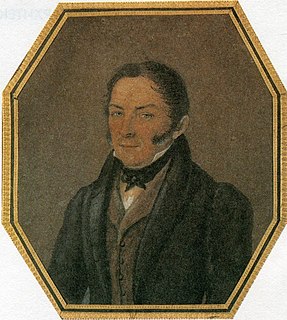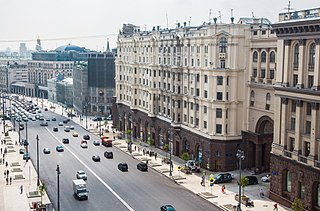
Wellington Arch, also known as Constitution Arch or (originally) as the Green Park Arch, is a Grade I-listed triumphal arch by Decimus Burton that forms a centrepiece of Hyde Park Corner in central London, between corners of Hyde Park and Green Park; it stands on a large traffic island with crossings for pedestrian access. From its construction in 1826 until 1830 the arch stood in a different location nearby; it was moved to its current site in 1882–1883. It originally supported a colossal equestrian statue of the 1st Duke of Wellington by the sculptor Matthew Cotes Wyatt, as a result of which it has acquired the name "the Wellington Arch" in the vernacular. A bronze quadriga by Adrian Jones has surmounted it since 1912.

Joseph Bové was an Italian-Russian neoclassical architect who supervised reconstruction of Moscow after the Fire of 1812.

The Narva Triumphal Arch was erected in the vast Narva Square, Saint Petersburg, in 1814 to commemorate the Russian victory over Napoleon.

Stalinist architecture, mostly known in the former Eastern Bloc as Stalinist Empire style or Socialist Classicism, is a term given to the architecture of the Soviet Union under the leadership of Joseph Stalin, between 1933 and 1955. Stalinist architecture is associated with the Socialist realism school of art and architecture.

Red Gate were triumphal arches built in an exuberantly baroque design in Moscow. Gates and arches of this type were common back in 18th century Moscow. However, the Red Gate was the only one that survived until the 20th century. It was demolished in 1928 and the name still survives in an eponymous Moscow Metro station.

Oktyabrskaya is a station on the Koltsevaya line of the Moscow Metro. Opened on 1 January 1950, Oktyabrskaya was part of the first segment of the fourth stage. Designed by Leonid Polyakov who took the mid-19th century Neoclassical triumphal Empire style as the basis, and incorporated the themes of the 1812 Victory over Napoleon to match the 1945 Soviet victory in the second world war, applying to the standard pylon tri-vault design.

The Garden Ring, also known as the "B" Ring, is a circular ring road avenue around central Moscow, its course corresponding to what used to be the city ramparts surrounding Zemlyanoy Gorod in the 17th century.

Krasnye Vorota is a Moscow Metro station in the Krasnoselsky District, Central Administrative Okrug, Moscow, Russia. It opened May 15, 1935 as one of the initial ten stations of the Metro. It is on the Sokolnicheskaya Line, between Chistye Prudy and Komsomolskaya stations.

Pushkinskaya is a station on Moscow Metro's Tagansko-Krasnopresnenskaya Line. Opened on 17 December 1975, along with Kuznetsky Most as the segment which linked the Zhdanovskaya and Krasnopresnenskaya Lines into one. Like its neighbour, the station was a column tri-vault type, which had not been seen in Moscow since the 1950s. Arguably the most beautiful station on the Line, the architects Vdovin and Bazhenov took every effort to make it appear to have a 'classical' 19th century setting. The central hall lighting is created with stylised 19th century chandeliers with two rows of plafonds appearing like candles, while the side platforms have candlesticks with similar plafonds. The columns, covered with 'Koelga' white marble are decorated with palm leaf reliefs and the grey marble walls are decorated with brass measured insertions based on the works of the great Russian poet Alexander Pushkin. The grey granite floor completes the appearance of the masterpiece. Architecturally the station put the final stop to the functionality economy design of the 1960s and went against Nikita Khrushchev's policy of struggle to avoid decorative 'extras', which left the stations of 1958–59 greatly altered in their design.

Tverskaya Street, known between 1935 and 1990 as Gorky Street, is the main radial street in Moscow. The street runs Northwest from the central Manege Square in the direction of Saint Petersburg and terminates at the Garden Ring, giving the name to Tverskoy District. The route continues further as First Tverskaya-Yamskaya Street, Leningradsky Avenue and Leningradskoye Highway.

Tverskoy District is a district of Central Administrative Okrug of the federal city of Moscow, Russia. Population: 75,378 (2010 Census); 75,955 (2002 Census).

Leningradsky Prospekt, or Leningrad Avenue, is a major arterial avenue in Moscow, Russia. It continues the path of Tverskaya Street and 1st Tverskaya-Yamskaya Street north-west from Belorussky Rail Terminal, and changes the name once again to Leningrad Highway past the Sokol metro station. The Highway continues its way to Saint Petersburg via Tver.

Belorussky railway terminal is a passenger terminal at the Moscow–Passenger–Smolenskaya railway station of the Moscow Railway. Informally the whole station can be called as Moscow Belorusskaya.

Kamer-Kollezhsky rampart was a rampart which was built by Kamer Collegium and became the last of the Moscow city walls. After demolishing of the ramparts and gates it became a ring of streets around the center of Moscow, Russia. It is the third historical ring of Moscow, with a total length of 37 kilometers, partially integrated into the modern Third Ring circular highway. Kamer-Kollezhsky Val is not a road ring in a strict sense, as it has no crossings over the Moskva River.

Ploshchad Ilyicha is a station on the Moscow Metro's Kalininsko-Solntsevskaya Line. It was opened on 30 December 1979 as part of the line's first stage.

White Square Office Center is a Class A office center located next to the Belorusskaya Metro Station in Moscow, Russia. It is known not only as a business center that houses such multinational companies as Deloitte, McKinsey & Company, WorldQuant and PricewaterhouseCoopers, but also as a community landmark, largely due to its fountain, piazza, mix of cafes and restaurants, community-focused events, and its view of the adjacent Nikolai Chudotvorets Church.

The Moscow–Brest Railway is about 1,100 km of Moscow Railway within Russian Railways.

The Moscow tramway network, which is divided into two sub-networks, is a key element of the public transport system in Moscow, the capital city of Russia. Opened in 1872, it has been operated since 1958 by Mosgortrans, a state-owned company.

The third and the oldest surviving Triumphal Arch in Moscow was built in 1829–34 on Tverskaya Zastava Square to Joseph Bové's designs in order to commemorate Russia's victory over Napoleon. It replaced an earlier wooden structure built by the veterans of the Napoleonic Wars in 1814.






















